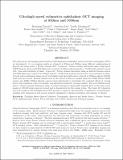Ultrahigh speed volumetric ophthalmic OCT imaging at 850nm and 1050nm
Author(s)
Potsaid, Benjamin M.; Liu, Jonathan Jaoshin; Manjunath, Varsha; Gorczynska, Iwona; Srinivasan, Vivek J.; Jiang, James; Barry, Scott; Cable, Alex E.; Duker, Jay S.; Fujimoto, James G.; ... Show more Show less
DownloadFujimoto-Ultrahigh-speed volumetric.pdf (1.060Mb)
PUBLISHER_POLICY
Publisher Policy
Article is made available in accordance with the publisher's policy and may be subject to US copyright law. Please refer to the publisher's site for terms of use.
Terms of use
Metadata
Show full item recordAbstract
The performance and imaging characteristics of ultrahigh speed ophthalmic optical coherence tomography (OCT) are investigated. In vivo imaging results are obtained at 850nm and 1050nm using different configurations of spectral and swept source / Fourier domain OCT. A spectral / Fourier domain instrument using a high speed CMOS linescan camera with SLD light source centered at 850nm achieves speeds of ~91,000 axial scans per second with ~3μm axial resolution in tissue. A spectral / Fourier domain instrument using an InGaAs linescan camera with SLD light source centered at 1050nm achieves ~47,000 axial scans per second with ~7μm resolution in tissue. A swept source instrument using a novel wavelength swept laser light source centered at 1050nm achieves 100,000 axial scans per second. Retinal diseases seen in the clinical setting are imaged using the 91kHz 850nm CMOS camera and 47kHz 1050nm InGaAs camera based instruments to investigate the combined effects of varying speed, axial resolution, center wavelength, and instrument sensitivity on image quality. The novel 1050nm swept source / Fourier domain instrument using a recently developed commercially available short cavity laser source images at 100,000 axial scans per second and is demonstrated in the normal retina. The dense 3D volumetric data sets obtained with ultrahigh speed OCT promise to improve reproducibility of quantitative measurements, enabling early diagnosis as well as more sensitive assessment of disease progression and response to therapy.
Date issued
2010-03Department
Massachusetts Institute of Technology. Department of Electrical Engineering and Computer Science; Massachusetts Institute of Technology. Research Laboratory of ElectronicsJournal
Proceedings of SPIE--the International Society for Optical Engineering; v. 7550
Publisher
SPIE
Citation
Benjamin Potsaid ; Jonathan Liu ; Varsha Manjunath ; Iwona Gorczynska ; Vivek J. Srinivasan ; James Jiang ; Scott Barry ; Alex Cable ; Jay S. Duker ; James G. Fujimoto; Ultrahigh-speed volumetric ophthalmic OCT imaging at 850nm and 1050nm. Proc. SPIE 7550, Ophthalmic Technologies XX, 75501K (March 02, 2010). SPIE © 2010
Version: Final published version
ISSN
0277-786X